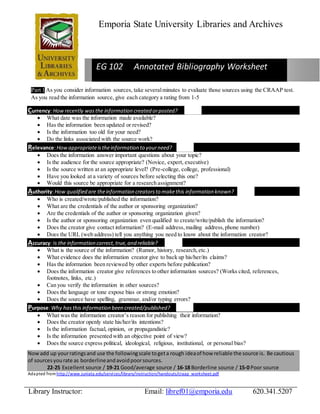Annotated bibliography worksheet
- 1. Emporia State University Libraries and Archives EG 102 Annotated Bibliography Worksheet Part 1 As you consider information sources, take several minutes to evaluate those sources using the CRAAP test. As you read the information source, give each category a rating from 1-5 Currency: How recently was the information created or posted?  What date was the information made available?  Has the information been updated or revised?  Is the information too old for your need?  Do the links associated with the source work? Relevance: How appropriate is the information to your need?  Does the information answer important questions about your topic?  Is the audience for the source appropriate? (Novice, expert, executive)  Is the source written at an appropriate level? (Pre-college, college, professional)  Have you looked at a variety of sources before selecting this one?  Would this source be appropriate for a research assignment? Authority: How qualified are the information creators to make this information known?  Who is created/wrote/published the information?  What are the credentials of the author or sponsoring organization?  Are the credentials of the author or sponsoring organization given?  Is the author or sponsoring organization even qualified to create/write/publish the information?  Does the creator give contact information? (E-mail address, mailing address, phone number)  Does the URL (web address) tell you anything you need to know about the information creator? Accuracy: Is the information correct, true, and reliable?  What is the source of the information? (Rumor, history, research, etc.)  What evidence does the information creator give to back up his/her/its claims?  Has the information been reviewed by other experts before publication?  Does the information creator give references to other information sources? (Works cited, references, footnotes, links, etc.)  Can you verify the information in other sources?  Does the language or tone expose bias or strong emotion?  Does the source have spelling, grammar, and/or typing errors? Purpose: Why has this information been created/published?  What was the information creator’s reason for publishing their information?  Does the creator openly state his/her/its intentions?  Is the information factual, opinion, or propagandistic?  Is the information presented with an objective point of view?  Does the source express political, ideological, religious, institutional, or personal bias? Now add up your ratings and use the following scale to get a rough idea of how reliable the source is. Be cautious of sources you rate as borderline and avoid poor sources. 22-25 Excellent source / 19-21 Good/average source / 16-18 Borderline source / 15-0 Poor source Adapted from http://www.juniata.edu/services/library/instruction/handouts/craap_worksheet.pdf Library Instructor: Email: libref01@emporia.edu 620.341.5207
- 2. Emporia State University Libraries and Archives Part 2 Fill in each box with the information it prompts. When you are done with this step, all you will need to do is craft your responses into good paragraphs for your annotations. Source citation: 1-2 statement summary of the source’s argument and conclusion: Statement on the source’s audience/purpose: Statement on the source’s timeliness/appropriateness: Statement on the source’s special features (helpful graphics, use of new technology or technique, particularly significant breakthrough, etc.): 1-2 statement evaluation of the source’s strengths/weaknesses/biases/usefulness to your paper: Library Instructor: Email: libref01@emporia.edu 620.341.5207


